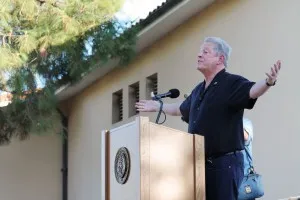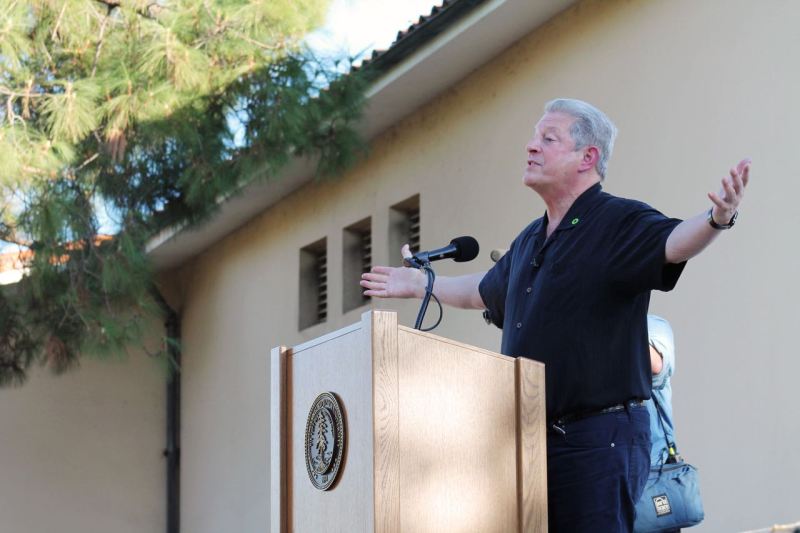
On Friday night, an estimated 2,000 people gathered in White Plaza for the Know Tomorrow rally, featuring former Vice President Al Gore. The event was part of a national Day of Action aimed to raise climate awareness in preparation for the 2015 United Nations Climate Change Conference in Paris this November and December.
The event was put on by Stanford student representatives from Know Tomorrow, a national organization, and members of Students for a Sustainable Stanford (SSS). In addition to Gore and representatives from his nonprofit The Climate Reality Project, speakers included Stanford faculty, ASSU Executives John-Lancaster Finley ’16 and Brandon Hill ’16 and members of student groups such as the Stanford American Indian Organization (SAIO) and Fossil Free Stanford. The Leland Stanford Junior University Marching Band (LSJUMB) and Talisman also performed at the two hour long event.
Hall Connolly, senior vice president of The Climate Reality Project, said that when the Know Tomorrow campaign approached the former vice president about speaking at Stanford, Gore’s organization saw it as a good opportunity to work with students.
“This generation is the one that will solve climate,” Connolly said. “And being here today, you could feel how excited the crowd was and how much energy there was.”
Former Vice President Gore Calls Students to Action
After taking selfies with several students on his way to the stage, the former vice president opened his speech by thanking the crowd but also charged them with a certain responsibility.
“The main solution to the climate crisis is right here – with your willingness to get involved,” Gore said.
Gore then said that there are really only three questions left for climate change: “Do we have to change?”, “Can we change?” and “Will we change?”
Addressing the first question of whether or not humans need to change to solve climate change, Gore spoke about both climate deniers and societal tendencies that encourage people to ignore the problem.
“We are telling all the big polluters it is okay to use the sky as a giant open sewer,” Gore said. “The answer to that question ‘do we have to change’ is abundantly clear.”
After recognizing the need for action, however, the former vice president had a more optimistic take on whether society can and will change. Gore answered the matter of ability to change by citing the unlikely examples of both the “Green” Tea Party from Atlanta, Georgia and the Christian Coalition – two environmentally active groups, despite being otherwise conservative.
In answering the final question, Gore’s answer was multi-faceted.
“We are winning this struggle; we just have to win faster,” he told the crowd.
Gore then declared that the climate change movement, to truly succeed, will have to match the scale, tactics and enthusiasm of other grand-sweeping social movements such as women’s suffrage, gay rights, the civil rights movement of the 1960s and Black Lives Matter today.
“This movement is in the tradition of every great moral movement that has advanced the equality of our society, and every single one of them has met resistance to where the advocates reached the point of despair but persevered,” he said. “We are close… to where this issue is resolved by the simple question of choosing between right and wrong. But because we are humans, the outcome is for-ordained.”
Harkening again to history but tailoring his message to the majority-student audience, the former vice president closed his address by describing his awe at the United States’ eight-year path to putting a man on the moon. According to Gore, the average age of the people in the NASA control room at the time was 26, making them just 18 years old when President John F. Kennedy first declared that the U.S. would put humans of the moon.
“Be persistent; be persuasive. The facts are on your side,” Gore said. “Political will is a renewable resource.”
Members of the Stanford Community Talk Climate Change
In addition to the former vice president’s speech, members of the local and campus community participated onstage. After an energetic opening from LSJUMB, organizers from SSS gave an introduction to the rally and acted as MCs for the event before the former vice president took the microphone.
Earth systems science professor Noah Diffenbaugh ’96 M.S. ’97 also spoke about his work as a Senior Fellow at the Woods Institute for the Environment. Joking about needing to use scientific jargon, Diffenbaugh told the crowd that when scientists record temperatures and see that they’re increasing, they call it “warming.”
“I embrace warming; I know that we’ve measured it,” Diffenbaugh said. “Global warming is not a matter of belief or ideology. If you believe in thermometers, you believe in global warming.”
Civil and environmental engineering professor Mark Jacobson ’87 M.S. ’88 discussed the progress that is being made toward clean energy around the world.
Jacobson argued that many clean energies are already economically viable, citing that wind is the cheapest form of energy in the United States by a factor of two, and that after capital and maintenance cost, wind and solar are free energy sources. According to Jacobson, nonprofits like his own Solutions Project have been effective at spreading such technologies.
ASSU President Finley and Vice President Hill took the stage following the two faculty members. The two received cheers from the crowd as they announced that they have reached out directly to the Stanford Board of Trustees demanding full divestment from fossil fuels, rather than just the current divestment from coal.
“Let the world know that we are here to fight,” Hill concluded. “We are here to act, and we are here to lead on climate change.”
Jasmin Vargas, representing Communities for a Better Climate, a Bay Area organization focused on environmental justice, told the crowd how she was inspired to study environmental science after attending a Radiohead concert during college where the band discussed the environmental crisis and implored the audience do something about it. Vargas changed her major to environmental studies soon after.
Following Vargas, Chasity Salvador ’17 performed a spoken word piece about growing up on a farm amid fires and water shortages. Salvador represented SAIO and spoke about the ways that climate change and environmental degradation affect indigenous communities.
For the final speech by student group representatives, Sijo Smith ’18 and Jenai Longstaff ’18 from Fossil Free Stanford addressed divestment from fossil fuels. Like Finley and Hill, they asked for a next level of action, saying that the Board of Trustees had heard the calls for divestment from the ASSU, the Graduate Student Council and over 375 faculty members.
Finally, Dominique Francks ’16, the Know Tomorrow campus representative, took the stage and told the crowd a story about literally passing out from fear after seeing “An Inconvenient Truth.”
“When I came home, I told my dad what had happened, and he gave me some advice,” Francks said. “‘If it scares you that badly, then go out there and change it.’”
Wrapping up
Throughout the rally, student volunteers asked attendees to sign the Know Tomorrow petition demanding leaders at the UN conference to “create a world with zero global warming pollution and zero extreme poverty” and asking that President Barack Obama sign “a strong agreement to cut emissions” at the Paris negotiations.
By the end of the event, organizers had collected approximately 2,000 signatures, which will be compiled with signatures collected from campuses across the country on the Day of Action.
“I think Stanford has a lot to be proud about in terms of this event,” Connolly said.
Contact Ada Throckmorton at adastat ‘at’ stanford.edu.
